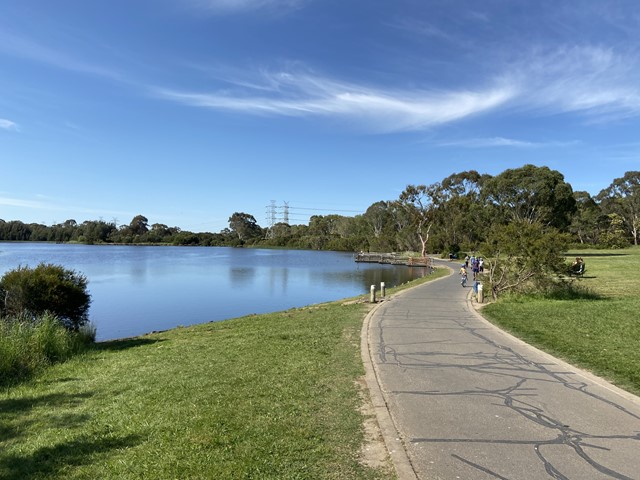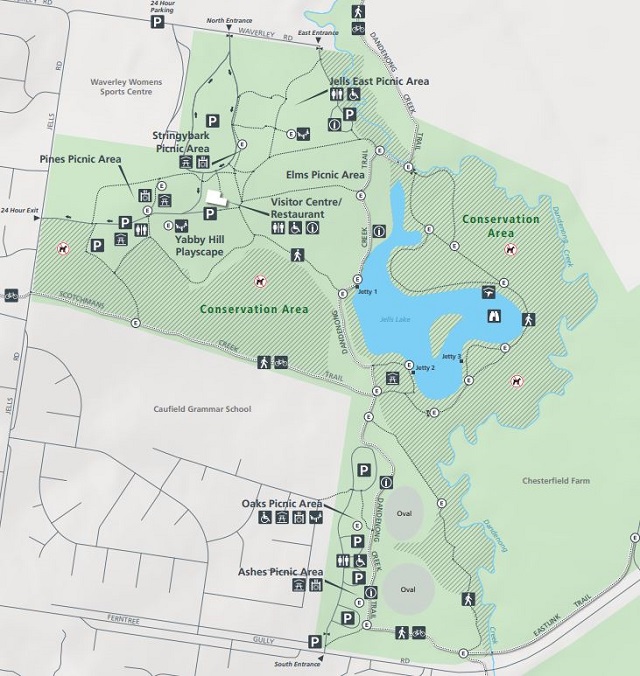Jells Park (Wheelers Hill)


Jells Park is at the hub of a network of parklands linked by the Dandenong Creek. Nestled in the heart of suburbia the park is abundant with native plants and wildlife and is a diverse recreation destination for the whole family - you can experience it all in Melbourne's backyard. With over nine kilometres of paths and trails, hectares of wide open spaces and picnic areas for everyone to enjoy, the park attracts over 1,000,000 visitors a year.
It is easy to see why Jells Park is so popular. It has so much to offer, with natural bushland, wonderful scenery and reminders of our history, protected for the future and ours to enjoy now.
Things to Do
- Experience the Dandenong Creek Trail on foot or by bike as it makes its way through a variety of bush landscapes and parklands.
- Enjoy a family get together at one of the many barbecue and picnic areas.
- The Yabbie Hill Playscape and two other playgrounds in the park provide an adventure wonderland for children.
- Relish the wide open spaces, panoramic lake views and the tranquillity of peaceful surroundings.
- Cycle, walk, run or rollerblade around a network of sealed trails.
- Fish from the jetties on the western side of the lake for redfin or short-finned eels and yabbies (valid Recreational Fishing Licence required).
- At the bird hide, you can view Australian native birds such as swamphens, darters, cormorants and pelicans as well as birds that migrate to Jells Park from Asia during summertime.
- The Oaks and Ashes ovals may be booked for large group outings or functions.
Facilities
- Eight picnic areas, each offering a different environmental ambience;
- Four with solid fuel BBQ's, wood provided;
- Two picnic grounds at Jells South providing free electric BBQs;.
- Six with picnic shelters;
- Each picnic area with water and toilets nearby;
- Three adventure playgrounds for the kids;
- A Liberty Swing at Jells South allows people in wheelchairs the fun of swinging;
- The Jells Park Visitor Centre provides visitor information about the parklands.
- Provides a licensed cafe/restaurant and takeaway kiosk
- Open for breakfast, lunch and dinner as well as catering and function services.
- Sit back and enjoy Sunday afternoon entertainment featuring live music from 1pm to 4pm.
Heritage
Jells Park is named after one of the earliest settlers Joseph Jell who grazed cattle in the mid to late 1800s. The park has an interesting history and was utilised as a piggery in the late 1930s to the 1960s and even a storage area for the American Army during the Second World War.
The area was originally the homelands of the Woiworrung (Wurundjeri) and Boonerwrung Aboriginal tribes who lived on the land for over 30,000 years prior to European settlement. Jells Park was officially opened in April 1976 and is now one of the most popular parks in Melbourne catering for over 1,000,000 visitors each year.
Fauna
The major habitat areas such as Jells Lake and the billabongs are linked by the Dandenong Creek and its tributaries. These areas are welcome havens for wildlife, especially birds, in a densely established urban environment.
Over 150 bird species either live in or visit the park so you are sure to see swamp hens, cormorants, herons, coots, native ducks and even the elegant pelican around the lake and in the wetlands of Jells Park. During the warmer months of the year a number of birds migrate to Jells Park from China and Japan to escape the cold winters of their homelands. They make Jells Park their home for several months of the year, and breed, rest and feed on fish and insects.
We ask that visitors do not feed the birds and animals that live in Jells Park. If birds eat bread they become unhealthy, dependent on people and easy prey for foxes and cats.
Vegetation
The 129 ha that make up Jells Park contain a diversity of vegetation communities. Along the Dandenong Creek and throughout the park's floodplains and wetlands, riparian plants and trees flourish, including melaluca and the rare Yarra gum. Up on the higher slopes, where the plants have adapted to lower water levels, dry forest species such as the stringybark and yellow box eucalypt prevail.
Remnant, indigenous vegetation still exists along the Dandenong Creek with 116 species of native plants being recorded in Jells Park alone. This vegetation plays an important role in sustaining over 200 species of animals including birds, mammals, reptiles, amphibians and fish that inhabit the park.
Opening Hours:
Open 24/7
Access for Dogs:
Dogs are allowed in Jells Park, except in the conservation area at the rear of the lake and other signposted bushland areas. Please consider the safety and enjoyment of other park users and wildlife by ensuring that your dog is restrained on a lead at all times. A short walk away is Nortons Park, which is a dog off lead park. Even though there are some areas where dogs are not permitted, there are still large pleasant areas where you can walk with your dog.
Dogs are prohibited from the shaded conservation areas on the map below.

How to Get There
Vehicle access to the Jells South picnic areas is available from Ferntree Gully Road. Access to the Visitor Centre, Madelines Restaurant and all other picnic areas is available from Waverley Road. Pedestrian paths are accessible along the Dandenong Creek Trail from Nortons Lane, Scotchmans Creek trail and Corhanwarrable wetlands. Alternatively take Waverley Bus 754 and 1753 from Glen Waverley.
Photos:
Location
998 Waverley Road, Wheelers Hill 3150 View Map
Web Links
→ Jells Park (Parks Victoria)
→ Jells Park Visitor Guide (PDF)
→ Madelines @ Jells
→ Madelines at Jells on Facebook
→ dandenongvalleyfriends.org.au








